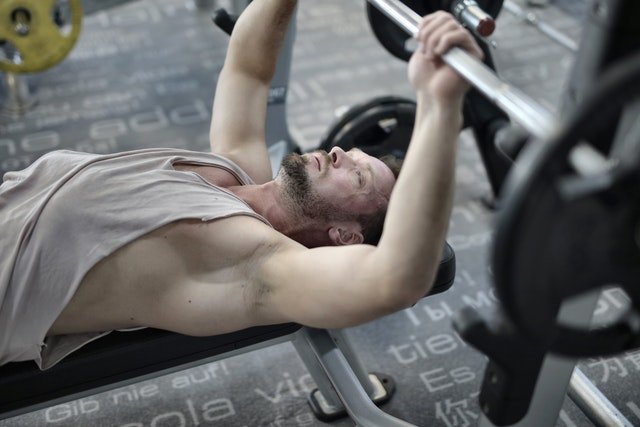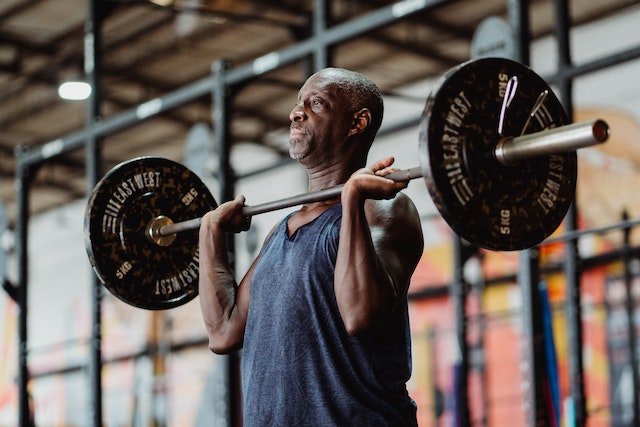
Why Is My Overhead Press So Bad? Everything You Need To Know For Getting Stronger
The overhead press is an important exercise for overall upper body strength. However, many people struggle to execute this move correctly.
It leaves you to ask “why is my overhead press so bad”.
There are many potential reasons due to the fact that the overhead press is a compound movement that engages multiple muscle groups.
Why is my overhead press so bad?
There are several reasons why your overhead press may be poorly executed. These include a lack of upper body strength, weak or disengaged core muscles, lack of full-body engagement, restricted range of motion, and poor breath control. Additionally, incorrect grip width, bringing the weight down too low, or overtraining can also lead to a less than optimal press. To improve your overhead press, focus on strengthening your rotator cuff and deltoid muscles, as well as increasing scapula mobility. Additionally, be sure to use a weight that is appropriate for your level of fitness, and focus on maintaining good form throughout the entire exercise.
If you want to see better results from your overhead press, focus on these key points which we are going to look at more in-depth below. With proper form and execution, you’ll be well on your way to a better press in no time.
Deltoids are a small muscle group
If you are new to lifting and finding that you are seeing good progress in many different areas of the body but not the overhead press, don’t feel disheartened as your deltoids are a small muscle group.
Seeing big gains in the early stages of lifting is common as your body is weak and has a lot of room to grow. Don’t worry though, with time and consistency, you will start to see results in your overhead press.
There are three heads to the deltoid muscle group – the anterior (front – RED), lateral (side – GREEN) and posterior (rear – BLUE). The overhead press targets all three heads, making it an important move for overall shoulder development, but can be hard to see initial progress as they are small muscles.
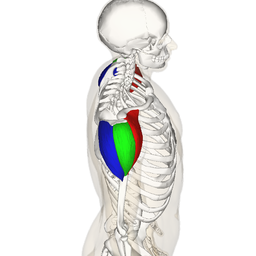
The overhead press is a compound movement
Another reason why your overhead press may be lagging is that it is a compound movement. This means that it engages multiple muscle groups, not just the deltoids.
The overhead press also works the triceps, chest, and core muscles. This can be taxing on the body, especially if you are new to lifting or haven’t been consistently working out.
To improve your overhead press, focus on strengthening all the muscle groups involved in the exercise. This will help you better execute the move and see results.
Your form may be incorrect
If you are struggling with your overhead press, it’s important to check your form. As it can lead to injuries and prevent you from seeing results.
As mentioned, the overhead press involves multiple muscle groups. This means that if one area is weak, the whole exercise can be thrown off.
Pinpointing the reasons why your overhead press isn’t improving can be difficult, so it may be helpful to seek out the guidance of a certified personal trainer or coach. They will be able to help you identify any areas that need improvement and give you specific tips on how to correct your form.
There are several things to keep in mind when pressing overhead.
Related: Why Is Shoulder Press So Hard? All The Answers For Rapid Progress
Your rushing the movement
Lifting the weight too quickly or not under control is a common mistake when pressing overhead. This can lead to injuries and cause you to miss the lift entirely.
When pressing overhead, be sure to move the weight slowly and under control. This will help you better engage the muscles and avoid injury.
Also, when lowering the weight back down, be sure to stop it before it hits your face. This can be a common mistake, as people often let the weight fall too low and with little control.
Allowing the weight to fall too low puts unnecessary stress on the shoulder joints and can lead to injury. Instead, lower the weight slowly and under control, stopping it before it hits your face or chest.
Lack of upper body strength
Some people fail to see results with their overhead press because they lack upper body strength. The overhead press is a compound movement that works multiple muscle groups, so if your upper body is weak, the exercise can be difficult to execute.
To build upper body strength, focus on exercises that target the muscles involved in the overhead press. This includes the deltoids, triceps, and chest.
Incorporating exercises like the bench press, lateral raises, face pulls, and tricep extensions into your workout routine will help you build the strength needed to improve your overhead press.
Additionally, be sure to use a weight that is appropriate for your level of fitness. Lifting too much weight can be difficult and can cause you to lose form, which can lead to injury.
Start with a lighter weight and focus on executing the exercise with proper form. As you build strength, you can increase the weight.
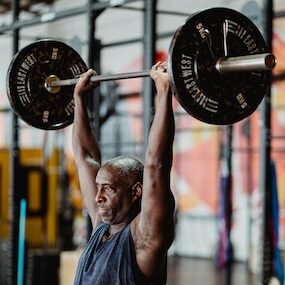
Weak or lack of engaged core
Another common reason people fail to see results with their overhead press is that their core muscles are weak or disengaged. The overhead press is a full-body exercise, which means that the entire body needs to be engaged in order for it to be executed correctly.
If your core muscles are weak, it can be difficult to maintain good form. This can lead to the weight being pressed too low or falling forward, which puts unnecessary stress on the shoulder joints and can lead to injury.
To engage your core during the overhead press, focus on maintaining a tall posture and keeping your abs and glutes tight.
This will help you keep the weight over your centre of gravity and avoid putting unnecessary stress on your shoulders.
You can improve your core strength by incorporating exercises like planks, sit-ups, and Russian twists into your workout routine.
Lack of full-body engagement
In order to correctly execute the overhead press, your entire body needs to be engaged. This means that your feet should be firmly planted on the ground, your core should be engaged, and your glutes should be tight.
If any of these areas are not engaged, it can lead to a poor press. For example, if your feet are not firmly planted, you may rock back and forth, which can cause you to lose balance and fall backwards.
Additionally, if your core is not engaged, you may arch your back or round your shoulders, which can lead to the weight being pressed too low.
Try to keep your whole body tight and engaged throughout the entire overhead press movement, which is working together as one to complete the movement. This will help you maintain good form and avoid injury.
Related: Why Are My Shoulders Never Sore? 16 Crucial Factors To Consider
Lack deltoid strength
Have you considered that you might need to isolate the shoulder musles to improve your overhead press?
The set of muscles responsible for the overhead press is the deltoids. The deltoids are a group of three muscles that make up the shoulder.
If these muscles are weak, it can be difficult to correctly execute the overhead press. Additionally, poor form can lead to the weight being pressed too low, which puts unnecessary stress on the shoulder joints and can lead to injury.
To build deltoid strength, focus on exercises that target the muscle group, such as lateral raises.
Incorporating these exercises into your workout routine will help you build the strength needed to improve your overhead press.
Grips too narrow or wide
Your grip width can also affect your overhead press. If your grip is too narrow, it can be difficult to press the weight overhead and put extra strain on your wrists. Additionally, a grip that is too wide can put unnecessary stress on the shoulder joints.
To find a grip width that is appropriate for you, start by placing your hands shoulder-width apart. From there, you can adjust your grip until you find a width that is comfortable for you.
Then make sure to maintain that width throughout the entire overhead press movement. This will help you keep good form and avoid injury.
Non vertical bar path
When you press the weight overhead, the bar should move in a straight line. If your bar path is not vertical, it can be difficult to press the weight overhead, especially if the weight is heavy and will also put unnecessary stress on the shoulder joints and lower back too.
To keep your bar path vertical, focus on pressing the weight straight up overhead.
The best way to practice the correct bar path would be to use a very light weight or no weight at all.
This will help you get a feel for the correct movement pattern before adding weight.
Avoid letting the weight drift forward or backwards, as this can lead to injury. Additionally, make sure to keep your elbows glued to your sides throughout the entire movement.
This will help you keep the weight over your centre of gravity and avoid putting unnecessary stress on your shoulders.
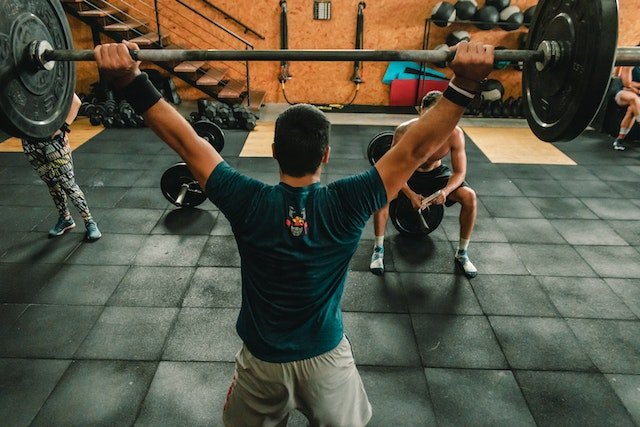
Squeeze glutes
One thing that gets overlooked a lot when people are overhead pressing is squeezing their glutes.
Squeezing your glutes helps to stabilise your lower body and gives you a strong foundation to press the weight from. It also helps to engage your core muscles, which can help to improve your overhead press.
Additionally, by keeping your glutes squeezed, you are less likely to rock back and forth or arch your back, which can lead to a poor press.
Doing this alone will not transform your overhead press, but it is a very important piece of the puzzle, which along with engaging your abs and keeping a strong back, will help you to improve your overhead press.
To squeeze your glutes, simply contract them as if you are trying to hold a penny between your cheeks.
Do this throughout the entire overhead press movement to ensure that you are getting the most out of the exercise. This will assist you in maintaining good form and avoiding accidents.
Restricted range of motion
If you have a restricted range of motion, it can be difficult to press the weight overhead and can also lead to injury.
Maybe you have tight muscles, maybe you’re not warmed up properly, or maybe you’re just not used to the movement.
Whatever the case may be, if you want to improve your overhead press, it’s important to focus on increasing your range of motion.
One way to do this is by using a foam roller or lacrosse ball to massage the muscles that may be tight.
Another way to increase your range of motion is by stretching the muscles that are tight.
A great stretch for the shoulder muscles is the door frame stretch. To do this stretch, stand in a doorway with your arms at 90-degree angles. Then, lean forward until you feel a stretch in your shoulders and hold for 30 seconds.
This stretch can be done several times per day to help increase your range of motion and improve your overhead press.
Additionally, make sure that you are warmed up properly before you start lifting. A simple 5-10 minute warm-up consisting of light cardio and dynamic stretching will help to increase your range of motion and prepare your muscles for the workout ahead.
Strengthen rotator cuff
If you want to improve your overhead press, focus on strengthening your rotator cuff.
The rotator cuff is a group of four muscles and tendons that attach the shoulder blade to the upper arm. These muscles help to stabilise the shoulder joint and allow for a greater range of motion.
The deltoid muscle is the large muscle that covers the shoulder joint. This muscle is responsible for lifting the arm overhead.
While the deltoid is the primary muscle used in the overhead press, the rotator cuff muscles play an important role in stabilising the shoulder joint and helping to lift the weight overhead.
There are a variety of exercises that you can do to strengthen your rotator cuff muscles. One exercise that is great for strengthening the rotator cuff muscles is the external rotation with a resistance band.
To do this exercise, tie a resistance band around a sturdy object and hold the band with your elbow at 90 degrees. Then, rotate your arm away from your body, maintaining the position of your elbow.
Do 3 sets of 10-15 repetitions on each side.
Swimmers shoulder
Swimmers shoulder is a condition that can be caused by repetitive overhead motions, such as those often used in swimming.
Swimmers shoulder often leads to rotator cuff tendinitis or bursitis. These conditions can be painful and make it difficult to move the arm.
If you have swimmers shoulder, it is important to rest the shoulder and avoid any overhead motions.
Ice can be applied to the shoulder to help reduce pain and inflammation. Physical therapy may also be recommended to help stretch and strengthen the muscles around the shoulder joint.
If you are a swimmer or have swimmers shoulder, focus on strengthening the rotator cuff muscles to help reduce pain and improve range of motion.
Perform the external rotation with a resistance band exercise 3 times per week to help strengthen the rotator cuff muscles.
Lack scapula mobility
Scapula mobility is important for overhead pressing movements. The scapula, or shoulder blade, is a large flat bone that sits on the back of the chest.
The scapula helps to stabilise the shoulder joint and allows for a greater range of motion.
If you have poor scapula mobility, it can be difficult to lift your arm overhead. This can lead to shoulder pain and decreased strength in the overhead press.
To improve scapula mobility, focus on stretching and strengthening the muscles around the shoulder blade.
One way to stretch the muscles around the scapula is by doing the doorway stretch that we mentioned earlier or the chest stretch.
To do the chest stretch, stand with your arms at your sides and your hands clasped in front of you. Then, lift your arms up and back as far as you can. Hold this position for 30 seconds.
Sit down to help improve stability
If you are struggling to keep your balance while doing overhead presses, try sitting down. This will help to improve your stability and will allow you to press the weight more effectively.
In addition, make sure that you are using a weight that you can handle.
If the weight is too heavy, it will be difficult to keep your balance and you will be more likely to injure yourself.

Breath work
In order to execute the overhead press correctly, you need to focus on your breath work.
Before you start the movement, take a deep breath in and fill your lungs with air. Then, as you press the weight overhead, exhale forcefully.
This will help to stabilise your core and increase the amount of power that you generate.
Additionally, make sure to exhale at the top of the movement. This will help to prevent any injuries.
When we lift a heavy weight, our bodies will naturally tense up sometimes to shift the weight. However, if we hold our breath while doing this, it can put unnecessary strain on our cardiovascular system.
Finding the right breathing rhythm is crucial when you are lifting weights. A good rule of thumb is to exhale on the exertion (when you are lifting the weight) and inhale on the way back down.
So remember to exhale as you press the weight overhead. This will help to increase power and prevent injuries.
Related: Why is my shoulder press so weak? All You Need to know for better results fast
Use appropriate weight
When performing the overhead press, it is important to use a weight that is appropriate for your level of fitness.
If the weight is too heavy, you will not be able to press it overhead and you may put yourself at risk for injury. You will compromise your form and will not be able to generate the most power possible.
On the other hand, if the weight is too light, you will not get the full benefit of the exercise.
To find the right weight, start with a light weight and gradually increase the amount of weight that you are using until you find a weight that is challenging but doable.
If you can press the weight overhead with good form, then the weight is appropriate for you.
Don’t psych yourself out
Many people tend to psych themselves out when it comes to a point in the workout where they have to lift a heavy weight or come to an exercise that they have found a challenge for any reason.
This is often because they are worried about failing or getting injured.
However, it is important to remember that everyone has to start somewhere. Plus, you will always get to a point where you plateau and you must find a way to get past it, everyone has to at some point.
It is also important that you focus on your form and technique rather than the amount of weight that you are lifting.
Do not be afraid to fail. If you try your best and focus on good form, you will eventually be able to press the weight overhead and turn things around.
Overtraining
Overtraining is a common issue when it comes to weightlifting.
This occurs when you train too frequently or with too much intensity and your body is unable to recover properly.
This can lead to a host of issues, including decreased performance, fatigue, and injuries.
To avoid overtraining, make sure that you are giving your body enough time to recover between workouts.
Additionally, make sure that you are not training to failure every time you work out. Leave some in the tank so that you can come back even stronger the next time.
If you find that you are constantly tired or not making the progress that you would like, then take a step back and reassess your training program.
You may need to reduce the frequency or intensity of your workouts. Everyone is different and there is no one-size-fits-all approach to training.
Listen to your body and make sure that you are giving it what it needs to recover and grow stronger.
Use these tips to improve your overhead press and start seeing the results that you have been working so hard for.
Final thoughts…
The overhead press is a great exercise for strengthening the shoulders, chest, and arms. However, it is important to make sure that you are using good form.
If you find that your overhead press is not progressing the way that you would like, then focus on strengthening your rotator cuff and deltoid muscles, as well as increasing scapula mobility. Use a weight that is appropriate for your level of fitness, and focus on maintaining good form.
Additionally, make sure that you are exhaling on the exertion and inhaling on the way back down. This will help to prevent injuries and increase power.
Finally, do not be afraid to fail. Everyone has to start somewhere. Focus on your form and technique, and the results will come.
Keep these tips in mind and start pressing your way to success!
Have your experienced this issue when working your shoulders, how did you get back on track? Let me know in the comments section below.


